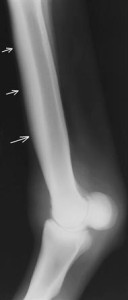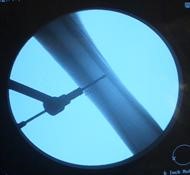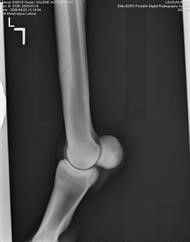Written by Petrisor Baia DVM Daniel J Burba DVM Neely Heidorn PhD 
Original Publish Date August 2014
A common bone problem that occurs in young race horses during the first few months in training is dorsal metacarpal disease, commonly known as bucked shins. In the racing industry, approximately 70 % of young Thoroughbreds are diagnosed with bucked shins, and 12% of them develop stress or saucer fractures of the forelimb cannon bones later in their career. This is a performance-limiting condition that besides the economic factor predisposes these animals at increased risk of catastrophic injuries.
Racehorse owners should understand and know how to prevent or treat bucked shins. Exercise is very healthy for humans and animals alike since the controlled stresses force our bodies to adapt and become stronger. Old bone is stripped away and replaced by new, stronger bone in areas that take the most stress, as in the cannon bone in horses. The body responds to hard training by thickening the front of the cannon bone. If training progresses too quickly and the body cannot keep up the stress on the bones with the bone remodeling process, then overexertion can lead to an inflammatory condition of the cannon bone known as bucked shins.
Clinical Presentation/Diagnosis
Initially the horse is reluctant to finish training and may be associated with lameness. In the mildest form, swelling and heat along the horse’s front shins indicate the horse is suffering from bucked shins. It can affect one or both front cannon bones, and running a finger quickly over the affected area will cause an immediate reaction due to the painful nature of this condition. Although bucked shins is a common problem to young horses, it can happen to any horse that is subjected to too much work before the horse’s body has had time to strengthen and adapt. It is just far easier to overstress a young and developing horse than it is to overstress a fully mature and developed horse. Radiographs can determine the degree of damage and provide the necessary information to decide the best course of action.
Treatment/Prevention
For the mild form of bucked shins, the goal of treatment is a combination of a short period of rest followed by a gradual increase in exercise to provide the bone time to heal and strengthen itself. Systemic and topical anti-inflammatories are helpful for pain control and with the healing process. For years, the preferred treatment for bucked shins involved pin-firing of the affected area by applying a hot iron to the skin over the front of the cannon bones The burning of tissue is supposed to strengthen the bone and decrease healing time by causing an acute inflammatory reaction. Although still used by some veterinarians, most vets feel firing is ineffective because the problem is in the bone, not the skin. The rest period associated with this type of treatment plays an important part. Complete stall rest is also not recommended because exercise is part of the healing process, and too much rest will allow the new bone growth to be reabsorbed, negating the positive effect of the stress. On the flip side, insufficient rest can cause these micro-fractures to complicate into more serious stress fractures because many horses will work through their pain, and it is our responsibility to make sure they don’t hurt themselves further.
Prevention
Laying a good foundation for the development of bone density through nutrition and proper stress on the bones should begin at birth. Once a horse reaches a higher level of performance training he should be moved up as slowly as possible using a program that includes an extended trot, gallops, and speed works.
 In conclusion, bucked shins do not have to be a part of normal training of young racing horses. There are many opinions about what’s the best way to treat bucked shins and prevention is by far the best “treatment” option. For more information regarding treatment of this issue please contact:
In conclusion, bucked shins do not have to be a part of normal training of young racing horses. There are many opinions about what’s the best way to treat bucked shins and prevention is by far the best “treatment” option. For more information regarding treatment of this issue please contact:
 Equine Health Studies Program School of Veterinary Medicine Louisiana State University Baton Rouge, LA 70803, Telephone: (225)-578-9500
Equine Health Studies Program School of Veterinary Medicine Louisiana State University Baton Rouge, LA 70803, Telephone: (225)-578-9500






